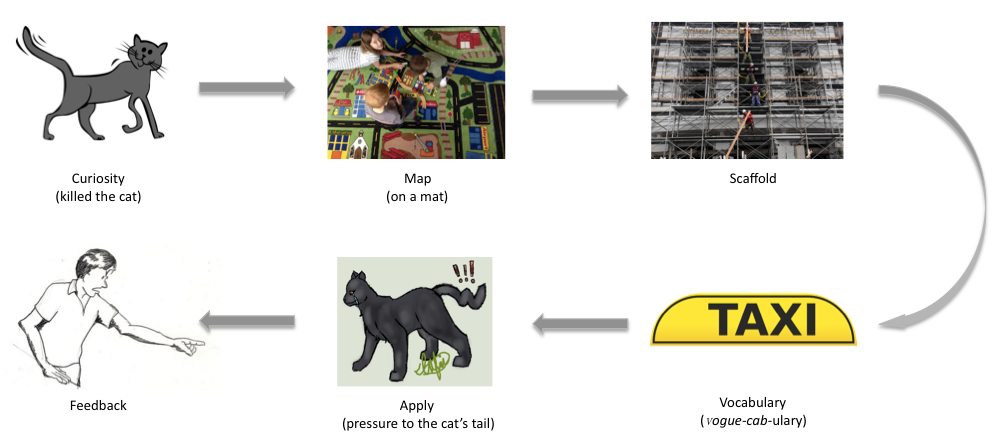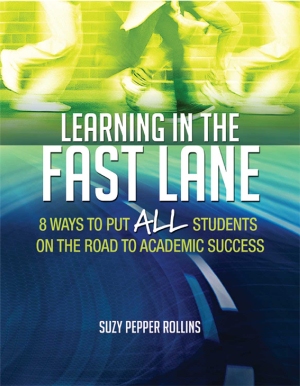This is an experimental post format. I’m using a story as a memory device to generate a solid ‘memory anchor’ on which to attach the following information. Hopefully the content of this article will stick in your head better than it would if it was just in text format!
I came across Learning in the Fast Lane when I attended an online webinar with the author, Suzy Pepper Rollins (read about that webinar here). I got so much out of the hour that I thought I’d make the time investment to read her whole book.
No regrets.
Here’s what I got. ..
The LITFL methodology consists of 6 steps that the books walks you through. Here’s an image and associated short story that I’ve put together to help me to remember the methodology.
So, this is the LITFL methodology.
- Generate Curiosity: “curiosity killed the cat”. A cat walks into a room
- Map Learning Goals: “the cat sat on the mat” The cat sits down on a mat, it’s one of those map-mats that kids sometimes play on
- Scaffold: The kids on the mat are building stuff
- Vocabulary: As you look closer, they’re building a taxi rank (cabs are in vogue… vogue-cab-ulary ; )
- Apply: One of the kids applies pressure to the cat’s tail!
- Feedback: A parent comes in and provides some feedback to that child!
Now look back up at the picture and link all of the concepts to the images, play the story over in your minds eye, and see if you can recall all of the 6 steps with ease.
Here’s those same points in Suzy’s words.
- Generate thinking, purpose, relevance and curiosity
- Clearly articulate learning goals and expectations
- Scaffold and practice pre-requisite skills
- Introduce and practice key vocabulary
- Apply the new concept to a task
- Regularly assess and provide feedback (ie: formative assessment)
Chapter Layout
In Chapter 1 Suzy outlines this methodology and each of the chapters thereafter delves into detail about each of these elements, and more.
This is one of those books where it’s obvious that the author actually thought about what it would be like to use their book as a resource. Let’s take chapter 5 (on Vocab) as an example. Each chapter begins with a justification of why that chapter exists. Suzy tells us the following at the beginning of Chapter 5 (numbers refer to kindle locations, information paraphrased)
- 1157: 3-year-olds from welfare families typically have 70%of the vocab of children living in working-class homes (Hart and Risley, 1995)
- 1164: kids in grades 4–12 who score at the 50th percentile know 6,000 more words than 25th percentilers. (Nagy & Herman) 1984)
- 1184: students need multiple exposures—typically, six—to new words to be able to grasp, retain, and use them (Jenkins et al, 1984)
- 1194: there is a strong correlation between vocabulary knowledge and reading comprehension. (Vacca & Vacca, 2002)
- 1204: students have just a 7 percent chance of understanding new words from dense text (Swanborn & de Glopper, 1999)
- 1220: all students who received direct vocab instruction outperformed those who didn’t. (Nagy and Townsend, 2012)
Great, now we know that vocab matters! Suzy then goes on to the section ‘Strategies to Develop Strong Vocabularies’ and lists 9 different methods of introducing new vocab, she also lets us know that learning with pictures is 37% more effective than just learning off definitions (that’s why I included pics at the start of this blog post!). My favourite one of these 9 methods is the TIP (A poster with Term, Information, Picture on it), which I wrote a bit more about here.
The chapter concludes with a “Checklist for vocabulary development” to ensure that you’re on track and for quick reference.
Every chapter is like this, it covers the Why, How and the What in a way that’s both practical and engaging. I got a lot out of this book and will continue to use it as a resource. I loved getting the whole picture from a front-to-back read but I think it would also be great as a quick reference guide for the educator who’s looking for ‘apply in class tomorrow’ kind of ideas.
See below for my summary notes. There’s a lot of them, it was a super info dense book and excellently referenced. Good stuff!
note: numbers refer to Kindle locations, click the ![]() image top right to make the display bigger in another page.
image top right to make the display bigger in another page.

